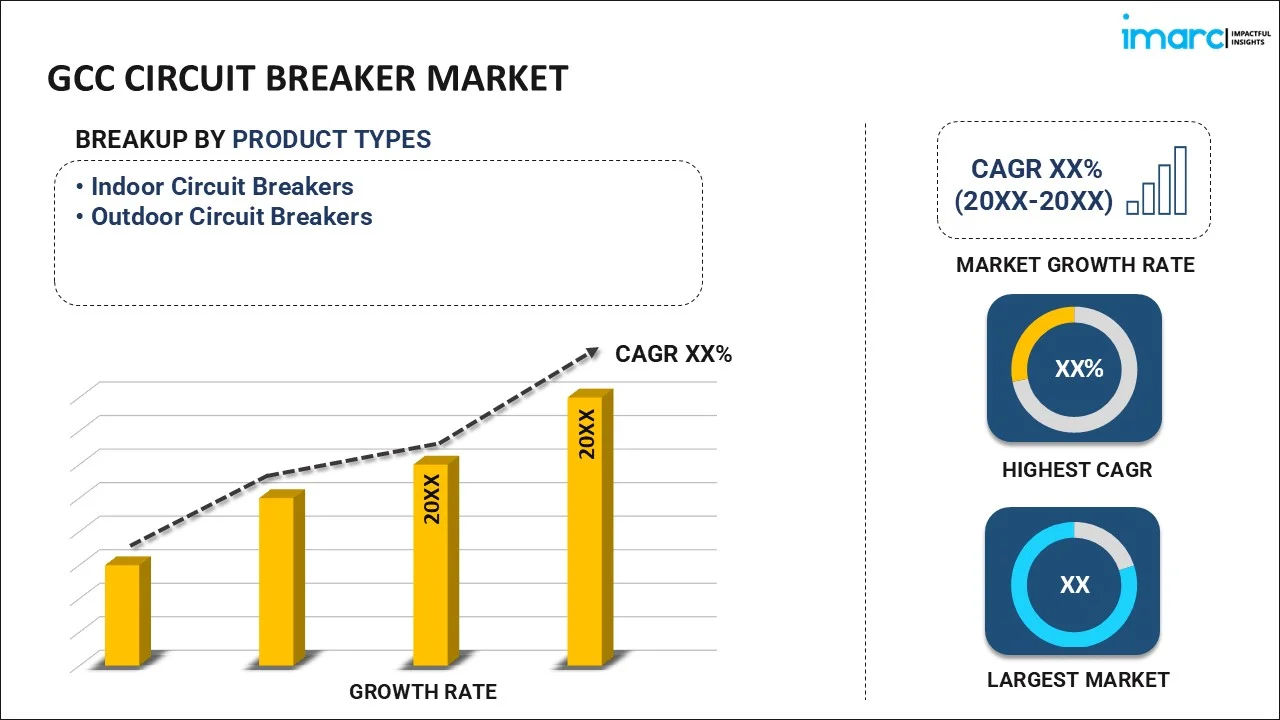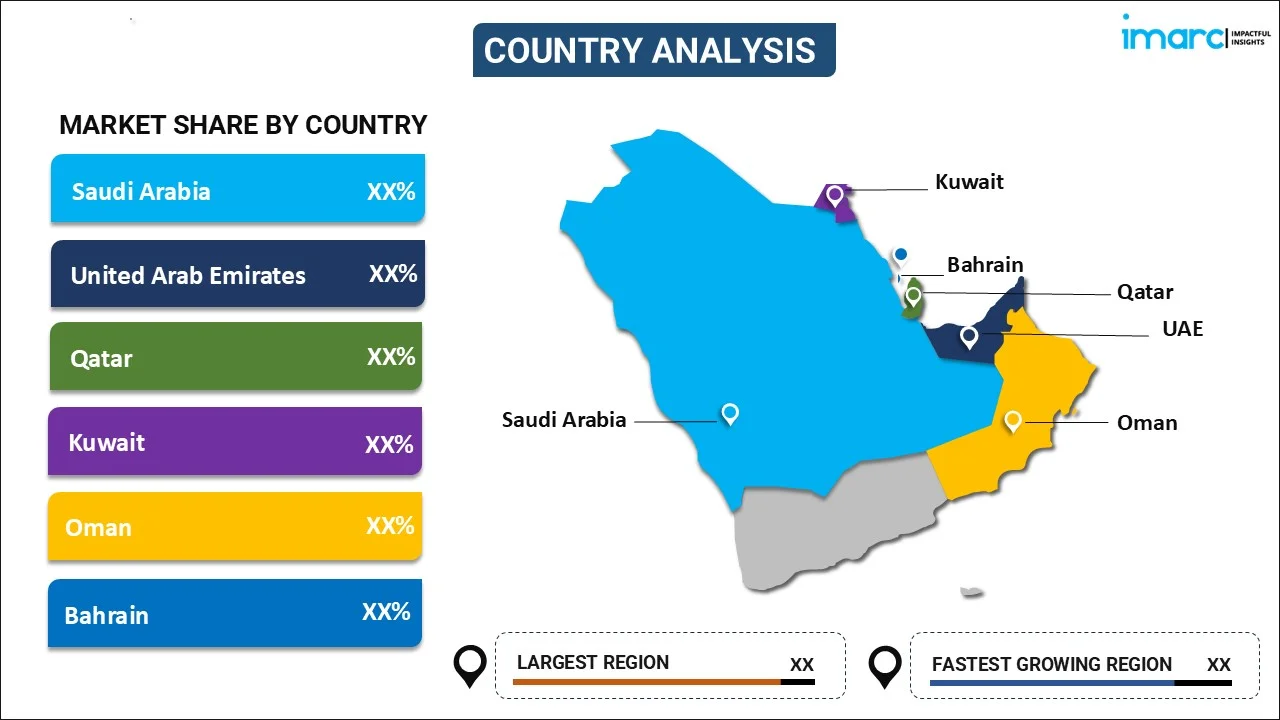
GCC Circuit Breaker Market Report by Product Type (Indoor Circuit Breakers, Outdoor Circuit Breakers), Voltage (Low Voltage, Medium Voltage, High Voltage), Technology (Air, Vacuum, Oil, SF6), End-Use (Transmission and Distribution, Renewable, Power Generation, Railways), and Country 2025-2033
Market Overview:
The GCC circuit breaker market size reached USD 165.6 Million in 2024. Looking forward, IMARC Group expects the market to reach USD 272.7 Million by 2033, exhibiting a growth rate (CAGR) of 5.4% during 2025-2033. The expanding infrastructural development, growing safety awareness, favorable government regulations, the bolstering power generation industry, and significant advancements in circuit breaker technology represent some of the key factors driving the market.
|
Report Attribute
|
Key Statistics
|
|---|---|
|
Base Year
|
2024 |
|
Forecast Years
|
2025-2033
|
|
Historical Years
|
2019-2024
|
| Market Size in 2024 | USD 165.6 Million |
| Market Forecast in 2033 | USD 272.7 Million |
| Market Growth Rate (2025-2033) | 5.4% |
A circuit breaker is an essential safety device used in electrical systems to protect against overloads and short circuits. It functions by interrupting the flow of electrical current when it exceeds the rated capacity of the circuit. This preventive action helps avoid potential hazards such as fires or damage to electrical equipment. The mechanism of a circuit breaker involves a tripping element that responds to abnormal currents. When an overload or short circuit occurs, the tripping element detects the excessive current flow and triggers the breaker to open the circuit, cutting off the electricity supply. This action halts the current flow and prevents further damage. Circuit breakers come in various types, including thermal, magnetic, and thermal-magnetic, each designed to respond to specific fault conditions. Thermal circuit breakers react to prolonged over currents, while magnetic ones respond to sudden, high-intensity currents. The thermal-magnetic type combines both functionalities for comprehensive protection. These devices are widely used in residential, commercial, and industrial applications.
GCC Circuit Breaker Market Trends:
The ongoing expansion of residential and commercial infrastructure projects across GCC countries, such as the United Arab Emirates, Saudi Arabia, and Qatar, is increasing the demand for electrical installations and distribution systems. As these developments continue, the need for reliable circuit breakers to protect against electrical overloads and short circuits is escalating, primarily driving the market growth. Moreover, the growing awareness among consumers and industries regarding electrical safety standards and regulations is fueling the adoption of advanced circuit protection solutions. Besides this, the implementation of stringent government regulations mandating the use of circuit breakers in construction and industrial activities is creating a favorable outlook for market expansion. In addition to this, the rise in power generation and transmission projects in the GCC region is a significant contributor to the circuit breaker market expansion. Concurrently, with increasing energy demands and a focus on renewable energy integration, there is a growing need for efficient and reliable circuit breakers in power distribution networks, which are aiding in market expansion. In line with this, the expanding shift towards smart grid technologies and automation in the power sector has created a demand for modern circuit breakers equipped with advanced features such as remote monitoring and control capabilities. Furthermore, continuous technological advancements in circuit breaker design, such as the incorporation of digital and solid-state technology, enhancing their performance, reliability, and efficiency, are positively impacting the market growth.
GCC Circuit Breaker Market Segmentation:
IMARC Group provides an analysis of the key trends in each segment of the GCC circuit breaker market report, along with forecasts at the regional and country levels for 2025-2033. Our report has categorized the market based on product type, voltage, technology, and end use.
Product Type Insights:

- Indoor Circuit Breakers
- Outdoor Circuit Breakers
The report has provided a detailed breakup and analysis of the market based on the product type. This includes indoor and outdoor circuit breakers.
Voltage Insights:
- Low Voltage
- Medium Voltage
- High Voltage
A detailed breakup and analysis of the market based on the voltage has also been provided in the report. This includes low, medium, and high voltage.
Technology Insights:
- Air
- Vacuum
- Oil
- SF6
The report has provided a detailed breakup and analysis of the market based on technology. This includes air, vacuum, oil, and SF6.
End-Use Insights:
- Transmission and Distribution
- Renewable
- Power Generation
- Railways
A detailed breakup and analysis of the market based on the end-use has also been provided in the report. This includes transmission and distribution, renewable, power generation, and railways.
Country Insights:

- Saudi Arabia
- UAE
- Qatar
- Oman
- Kuwait
- Bahrain
The report has also provided a comprehensive analysis of all the major regional markets, which include Saudi Arabia, UAE, Qatar, Bahrain, Kuwait, and Oman.
Competitive Landscape:
The report has also provided a comprehensive analysis of the competitive landscape in the market. Competitive analysis such as market structure, key player positioning, top winning strategies, competitive dashboard, and company evaluation quadrant has been covered in the report. Also, detailed profiles of all major companies have been provided.
GCC Circuit Breaker Market Report Coverage:
| Report Features | Details |
|---|---|
| Base Year of the Analysis | 2024 |
| Historical Period | 2019-2024 |
| Forecast Period | 2025-2033 |
| Units | Million USD |
| Scope of the Report | Exploration of Historical and Forecast Trends, Industry Catalysts and Challenges, Segment-Wise Historical and Predictive Market Assessment:
|
| Product Types Covered | Indoor Circuit Breaker, Outdoor Circuit Breaker |
| Voltages Covered | Low Voltage, Medium Voltage, High Voltage |
| Technologies Covered | Air, Vacuum, Oil, SF6 |
| End-Uses Covered | Transmission and Distribution, Renewable, Power Generation, Railways |
| Countries Covered | Saudi Arabia, UAE, Qatar, Bahrain, Kuwait, and Oman |
| Customization Scope | 10% Free Customization |
| Post-Sale Analyst Support | 10-12 Weeks |
| Delivery Format | PDF and Excel through Email (We can also provide the editable version of the report in PPT/Word format on special request) |
Key Questions Answered in This Report:
- How has the GCC circuit breaker market performed so far and how will it perform in the coming years?
- What has been the impact of COVID-19 on the GCC circuit breaker market?
- What is the breakup of the GCC circuit breaker market on the basis of product type?
- What is the breakup of the GCC circuit breaker market on the basis of voltage?
- What is the breakup of the GCC circuit breaker market on the basis of technology?
- What is the breakup of the GCC circuit breaker market on the basis of end use?
- What are the various stages in the value chain of the GCC circuit breaker market?
- What are the key driving factors and challenges in the GCC circuit breaker market?
- What is the structure of the GCC circuit breaker market and who are the key players?
- What is the degree of competition in the GCC circuit breaker market?
Key Benefits for Stakeholders:
- IMARC’s report offers a comprehensive quantitative analysis of various market segments, historical and current market trends, market forecasts, and dynamics of the GCC circuit breaker market from 2019-2033.
- The research study provides the latest information on the market drivers, challenges, and opportunities in the GCC circuit breaker market.
- Porter's five forces analysis assist stakeholders in assessing the impact of new entrants, competitive rivalry, supplier power, buyer power, and the threat of substitution. It helps stakeholders to analyze the level of competition within the GCC circuit breaker industry and its attractiveness.
- Competitive landscape allows stakeholders to understand their competitive environment and provides an insight into the current positions of key players in the market.
Need more help?
- Speak to our experienced analysts for insights on the current market scenarios.
- Include additional segments and countries to customize the report as per your requirement.
- Gain an unparalleled competitive advantage in your domain by understanding how to utilize the report and positively impacting your operations and revenue.
- For further assistance, please connect with our analysts.
 Inquire Before Buying
Inquire Before Buying
 Speak to an Analyst
Speak to an Analyst
 Request Brochure
Request Brochure
 Request Customization
Request Customization




.webp)




.webp)












